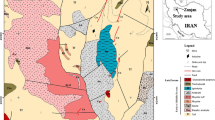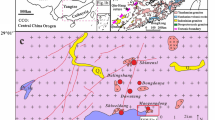Abstract
The Dongpo tungsten ore deposit, the largest scheelite skarn deposit in China, is located at the contact of a 172-m. y. biotite granite with a Devonian marble. The mineralization associated with the granite includes W, Bi-Mo, Cu-Sn and Pb-Zn ores. Several W mineralization stages are shown by the occurrence of ore in massive skarn deposits and in later cross-cutting veins. The high garnet/pyroxene ratio, the hedenbergite and diopside-rich pyroxene and the andradite-rich garnet show the deposit belongs to the oxidized skarn type. Detailed fluid inclusion studies of granite, greisen, skarn and vein samples reveal three types of fluid inclusion: (1) liquid-rich, (2) gas-rich and (3) inclusions with several daughter minerals. Type (3) is by far the most common in both skarn and vein samples. The dominant daughter mineral in fluid inclusions is rhembic, highly birefringent, and does not dissolve on heating even at 530°C. We assume that this mineral is calcite. The liquid phase in most of the fluid inclusions has low to moderate salinities: 0–15 wt. %; in a few has higher salinities (30–40 wt. % NaCl equivalent). The homogenization temperatures of inclusions in the skarn stage range from 350°C to 530°C, later tungsten mineralization-stage inclusions homogenize between 200°C and 300°C, as do inclusions in veins. Fluid inclusions in granite and greisen resemble those of the late tungsten mineralization stage, with low salinity and homogenization temperatures of 200°–360°C. The tungsten-forming fluids are probably a mixture that came from biotite granite and the surrounding country rocks.
Similar content being viewed by others
References
Vinogradov, A. P., Geokhimiya (1962), 641–664 (in Russian).
Institute of Geochemistry, Academia Sinica,Geochemistry of Granites in South China, Science Press, Beijing, 1979, pp. 421 (in Chinese).
Einaudi, M. T., Meinert, L. D., and Newberry, R. J., Econ. Geol. 75th Anniversary Vol. (1981), 317–391.
Yin, H., Geochimica, 4(1978), 270–280 (in Chinese).
Einaudi, M. T., and Burt, D. M., Econ. Geol., 77(1982), 745–754.
Roedder, E.,Geochemistry of Hydrothermal Ore Deposits, Holt, Rinehart and Winston, New York, 1967, 515–574.
Roedder, E., Schweiz. Min. Pet. Mitt. 50(1970), 41–58.
Poty, B., Leroy, J., et Jachimowicz, L., Bull. Soc. Mineral. Crystall., 99(1976), 182–186.
Roedder, E. and Bodnar, R. J., Ann. Review Earth Planetary Sci., 8(1980), 263–301.
Lin, R., Wei, K. and Wang, Z., Geochimica, 4(1981), 391–396 (in Chinese).
Burnham, C. W.,Geochemistry of Hydrothermal Ore Deposits, 2nd ed. John Wiley and Sons, New York, 1979, 71–136.
Author information
Authors and Affiliations
Rights and permissions
About this article
Cite this article
Lu, H., Crawford, M.L. Geological and fluid inclusion studies of the Dongpo tungsten skarn ore deposit, China. Chin. J. of Geochem. 5, 140–157 (1986). https://doi.org/10.1007/BF02885386
Issue Date:
DOI: https://doi.org/10.1007/BF02885386




